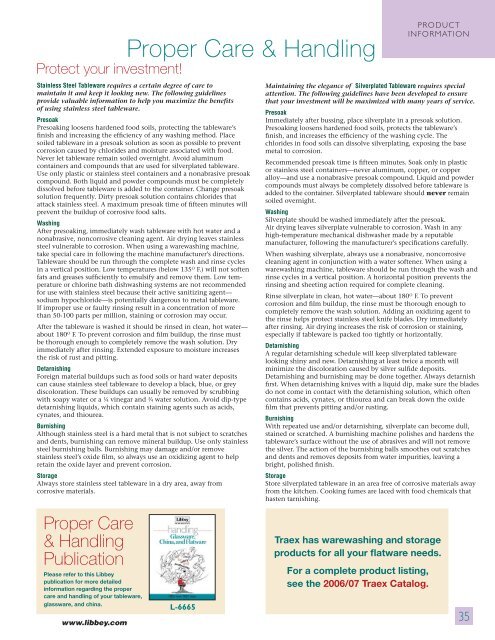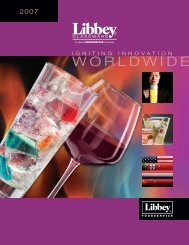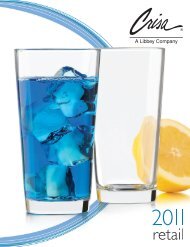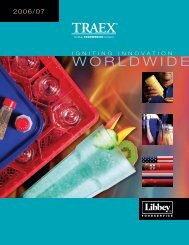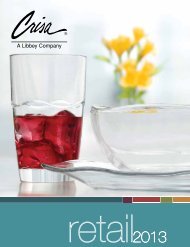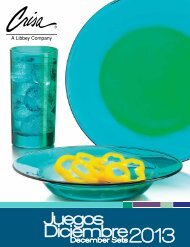You also want an ePaper? Increase the reach of your titles
YUMPU automatically turns print PDFs into web optimized ePapers that Google loves.
Protect your investment!<br />
www.libbey.com<br />
Proper Care & Handling<br />
Stainless Steel Tableware requires a certain degree of care to<br />
maintain it and keep it looking new. The following guidelines<br />
provide valuable information to help you maximize the benefi ts<br />
of using stainless steel tableware.<br />
Presoak<br />
Presoaking loosens hardened food soils, protecting the tableware’s<br />
fi nish and increasing the effi ciency of any washing method. Place<br />
soiled tableware in a presoak solution as soon as possible to prevent<br />
corrosion caused by chlorides and moisture associated with food.<br />
Never let tableware remain soiled overnight. Avoid aluminum<br />
containers and compounds that are used for silverplated tableware.<br />
Use only plastic or stainless steel containers and a nonabrasive presoak<br />
compound. Both liquid and powder compounds must be completely<br />
dissolved before tableware is added to the container. Change presoak<br />
solution frequently. Dirty presoak solution contains chlorides that<br />
attack stainless steel. A maximum presoak time of fi fteen minutes will<br />
prevent the buildup of corrosive food salts.<br />
Washing<br />
After presoaking, immediately wash tableware with hot water and a<br />
nonabrasive, noncorrosive cleaning agent. Air drying leaves stainless<br />
steel vulnerable to corrosion. When using a warewashing machine,<br />
take special care in following the machine manufacturer’s directions.<br />
Tableware should be run through the complete wash and rinse cycles<br />
in a vertical position. Low temperatures (below 135O F.) will not soften<br />
fats and greases suffi ciently to emulsify and remove them. Low temperature<br />
or chlorine bath dishwashing systems are not recommended<br />
for use with stainless steel because their active sanitizing agent—<br />
sodium hypochloride—is potentially dangerous to metal tableware.<br />
If improper use or faulty rinsing result in a concentration of more<br />
than 50-100 parts per million, staining or corrosion may occur.<br />
After the tableware is washed it should be rinsed in clean, hot water—<br />
about 180O F. To prevent corrosion and fi lm buildup, the rinse must<br />
be thorough enough to completely remove the wash solution. Dry<br />
immediately after rinsing. Extended exposure to moisture increases<br />
the risk of rust and pitting.<br />
Detarnishing<br />
Foreign material buildups such as food soils or hard water deposits<br />
can cause stainless steel tableware to develop a black, blue, or grey<br />
discoloration. These buildups can usually be removed by scrubbing<br />
with soapy water or a 1 ⁄4 vinegar and 3 ⁄4 water solution. Avoid dip-type<br />
detarnishing liquids, which contain staining agents such as acids,<br />
cynates, and thiourea.<br />
Burnishing<br />
Although stainless steel is a hard metal that is not subject to scratches<br />
and dents, burnishing can remove mineral buildup. Use only stainless<br />
steel burnishing balls. Burnishing may damage and/or remove<br />
stainless steel’s oxide fi lm, so always use an oxidizing agent to help<br />
retain the oxide layer and prevent corrosion.<br />
Storage<br />
Always store stainless steel tableware in a dry area, away from<br />
corrosive materials.<br />
Proper Care<br />
& Handling<br />
Publication<br />
Please refer to this Libbey<br />
publication for more detailed<br />
information regarding the proper<br />
care and handling of your tableware,<br />
glassware, and china.<br />
L-6665<br />
PRODUCT<br />
INFORMATION<br />
Maintaining the elegance of Silverplated Tableware requires special<br />
attention. The following guidelines have been developed to ensure<br />
that your investment will be maximized with many years of service.<br />
Presoak<br />
Immediately after bussing, place silverplate in a presoak solution.<br />
Presoaking loosens hardened food soils, protects the tableware’s<br />
fi nish, and increases the effi ciency of the washing cycle. The<br />
chlorides in food soils can dissolve silverplating, exposing the base<br />
metal to corrosion.<br />
Recommended presoak time is fi fteen minutes. Soak only in plastic<br />
or stainless steel containers—never aluminum, copper, or copper<br />
alloy—and use a nonabrasive presoak compound. Liquid and powder<br />
compounds must always be completely dissolved before tableware is<br />
added to the container. Silverplated tableware should never remain<br />
soiled overnight.<br />
Washing<br />
Silverplate should be washed immediately after the presoak.<br />
Air drying leaves silverplate vulnerable to corrosion. Wash in any<br />
high-temperature mechanical dishwasher made by a reputable<br />
manufacturer, following the manufacturer’s specifi cations carefully.<br />
When washing silverplate, always use a nonabrasive, noncorrosive<br />
cleaning agent in conjunction with a water softener. When using a<br />
warewashing machine, tableware should be run through the wash and<br />
rinse cycles in a vertical position. A horizontal position prevents the<br />
rinsing and sheeting action required for complete cleaning.<br />
Rinse silverplate in clean, hot water—about 180O F. To prevent<br />
corrosion and fi lm buildup, the rinse must be thorough enough to<br />
completely remove the wash solution. Adding an oxidizing agent to<br />
the rinse helps protect stainless steel knife blades. Dry immediately<br />
after rinsing. Air drying increases the risk of corrosion or staining,<br />
especially if tableware is packed too tightly or horizontally.<br />
Detarnishing<br />
A regular detarnishing schedule will keep silverplated tableware<br />
looking shiny and new. Detarnishing at least twice a month will<br />
minimize the discoloration caused by silver sulfi de deposits.<br />
Detarnishing and burnishing may be done together. Always detarnish<br />
fi rst. When detarnishing knives with a liquid dip, make sure the blades<br />
do not come in contact with the detarnishing solution, which often<br />
contains acids, cynates, or thiourea and can break down the oxide<br />
fi lm that prevents pitting and/or rusting.<br />
Burnishing<br />
With repeated use and/or detarnishing, silverplate can become dull,<br />
stained or scratched. A burnishing machine polishes and hardens the<br />
tableware’s surface without the use of abrasives and will not remove<br />
the silver. The action of the burnishing balls smoothes out scratches<br />
and dents and removes deposits from water impurities, leaving a<br />
bright, polished fi nish.<br />
Storage<br />
Store silverplated tableware in an area free of corrosive materials away<br />
from the kitchen. Cooking fumes are laced with food chemicals that<br />
hasten tarnishing.<br />
Traex has warewashing and storage<br />
products for all your fl atware needs.<br />
For a complete product listing,<br />
see the 2006/07 Traex Catalog.<br />
35


